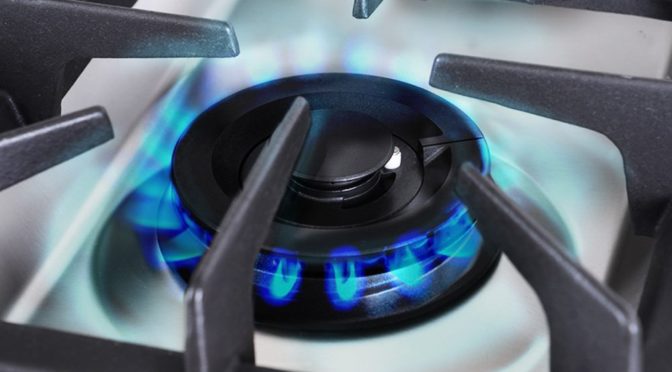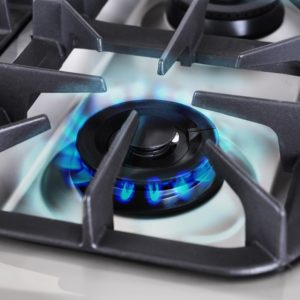
Commercial grade! Hotter than the surface of the sun! Tens of thousands of BTUs! You’ll hear a lot of these phrases when you dive into the world of magazine-quality kitchens and luxury ranges and ovens. But as is always the case with any big purchase, it pays to spend a bit of time learning terminology to help you make the right decision. Today we’ll explain what BTUs are and if there is a minimum threshold of them that your kitchen stove needs to be worth buying. We’ll also answer the question of whether bigger is always better when comparing models with BTUs.
What are BTUs, and are they used with gas or electric stoves?
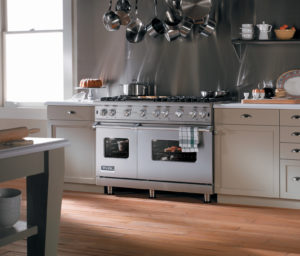
BTUs stand for British thermal units. They’re simply a common way of measuring the amount of heat your gas burner is delivering. You’ll find the metric used to describe burners, ovens, and broilers, and is generally used as a shorthand to compare the heating power of different burners. Practically speaking, it’s the amount of energy needed to induce a one degree Fahrenheit temperature increase in a pound of water.
While you’ll occasionally see electric stove power capacities delivered in BTUs, it’s far more common to see measurements given in watts. To convert the two, keep in mind that watts are units of power (i.e., energy dispensed over time) while BTUs are units of energy. As a result, a watt is approximately 3.412 BTUs dispensed each hour. Alternatively, .2931 watt hours are equivalent to one BTU. A high end range like a Viking 48″ range can put out up to a combined 123,000 BTUs when all burners are activated.
When it comes to BTUs, more are always going to be better, right?
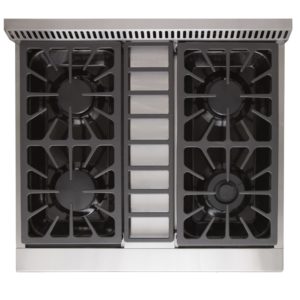
Not necessarily. While there’s something undeniably fun about playing with high BTUs, roaring flames, and sizzling, seared food, the truth is that you don’t need that much power for the vast majority of things you’ll cook on a home range. The few exceptions would include stir-fries that are best cooked with high heat and inside a wok. But if you’re buying a range for a home kitchen, you’re going to pay a lot of money to bring home those additional BTUs, and it’s not necessarily going to be worth it. On top of that, high heat ranges can lead to scorched cookware if you don’t know what you’re doing, and you’ll need to pay more attention to heat levels to keep things under control–not to mention to whoever else you allow near your range.
How many BTUs does my range or stove need for me to cook well with it?
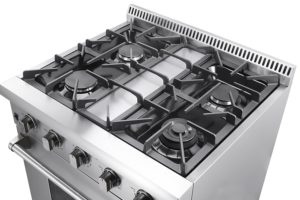
At this point, you might simply be wondering what the minimum necessary threshold is for BTUs on a home stove. The truth is that you can make do with a lot less than marketing would lead you to believe. On average, you’ll find most home stoves feature somewhere around 7,000 BTUs on each burner, and this is generally enough for typical cooking as long as you aren’t in a hurry. You’ll also find lower output burners that make it easier to simmer and cook with low heat; such burners may only generate 5,000, 3,000, or even fewer BTUs. You might also find burners with a high top end (e.g., 18,000 or even more BTUs) as well as a low low end (e.g., 600 BTUs) to give you full flexibility in power output and cooking options.
Can you boil water quickly? Can you control heat precisely?

The general guideline is to budget for enough BTUs to boil a gallon of water in a few minutes; if your burner can do that, it’ll be more than strong enough for most everything you can throw at it. It’s even more important, as noted above, that your burners have a wide, dynamic range. This means burners that you can turn up high enough to sear, back down to medium levels for frying, and drop all the way down to low levels for simmering. If you buy a stove that only has low and high modes or doesn’t even have a low mode and only delivers all heat, all the time, that’s going to make it hard to cook. Focus on responsiveness and ease of control instead of on pure BTUS.
Finally, consider your range vent hood requirements when searching for BTUs. If you buy a high BTU output range, you might need to upgrade your range hood to be able to effectively vent your kitchen when using the range at maximum power.
What are the best value ranges with high BTUs on the market today?
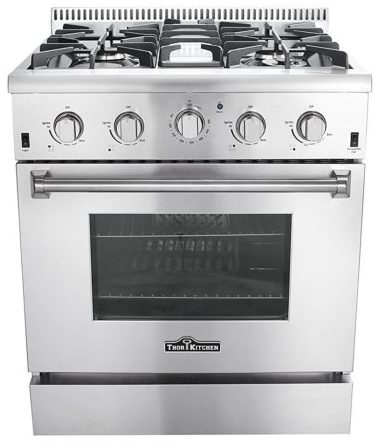
If you’re in search of a quality range with ample BTUs that won’t break the bank, we recommend a popular stainless steel 30″ range sold by Thor Kitchen and Kucht alike. It’s a professional-grade range with a combination of 4 powerful burners (the strongest of which generates up to 18,500 BTU), a convection oven, and a boiler. It’s marketed as the Thor Kitchen HRG3080U 30″ gas range (reviewed here) and the Kucht KRG3080U 30″ gas range (reviewed here). The ranges are built to the same standards, but we generally recommend buying it from Kucht instead of from Thor Kitchen because Kucht provides better customer service, which is more than valuable enough to offset the slightly higher price.
![]() You can buy the Thor Kitchen HRG3080U 30″ freestanding gas range here on Amazon or buy the Kucht KRG3080U range here instead.
You can buy the Thor Kitchen HRG3080U 30″ freestanding gas range here on Amazon or buy the Kucht KRG3080U range here instead.
![]() Canadians can buy the Thor Kitchen HRG3080U 30″ freestanding gas range here on Amazon or buy the Kucht KRG3080U range, which is cheaper, instead.
Canadians can buy the Thor Kitchen HRG3080U 30″ freestanding gas range here on Amazon or buy the Kucht KRG3080U range, which is cheaper, instead.
 If you find our research on PMC helpful, you can follow our efforts to keep maniacally reviewing home appliances by shopping through our links above. We promise to keep fighting the good fight against every horror children, animals, and grown, yet messy humans can inflict upon a clean home.
If you find our research on PMC helpful, you can follow our efforts to keep maniacally reviewing home appliances by shopping through our links above. We promise to keep fighting the good fight against every horror children, animals, and grown, yet messy humans can inflict upon a clean home.

